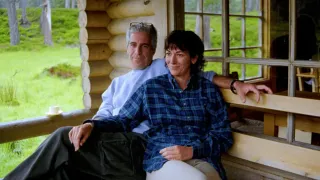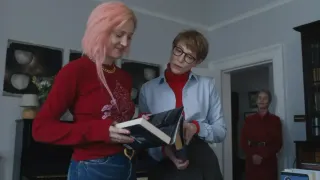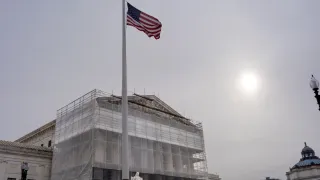July 20, 2014
San Fran's 'Flagging in the Park'
Kilian Melloy READ TIME: 6 MIN.
Flagging in the Park, the celebratory fabric-spinning party and commemoration, returns to the National AIDS Memorial Grove next Saturday, July 26. A combination of festive outdoor event and fundraiser, the roots of the swirling tie-dyed dance form goes back to the earliest days of gay culture, and even decades before.
For organizer Xavier Caylor, flagging brought him to San Francisco. And while he almost left his heart here, he's become devoted to these events.
After learning the basics of the movement form in 1997 on Will Rogers Beach in Santa Monica, Caylor visited San Francisco, fell in love with a man, and the city, and has since been an integral part of the events for more than a decade.
"I fell in love through flagging, so it has a special place in my heart," said Caylor, who has co-produced most of the events, and also works as an American Sign Language interpreter. This year, Grass Roots Gay Rights West (the Real Bad dance event producers) is working with the flaggers on a series of fundraisers for local AIDS/HIV nonprofits.
Colorful flags and dance music in an otherwise quiet park landscaped specifically to commemorate those lost to AIDS may seem incongruous to some. But for the tribe of flaggers, poi dancers and their friends, it's a perfect union of the somber, the celebratory, and yes, even the sexy.
"Our pre-Dore event is annually the biggest," said Caylor of the well-timed midsummer event that's scheduled a day before the Up Your Alley Street Fair in South of Market. "So many people are in town for that, and there is a loose connection between flaggers and the leather community. There's even a term, 'flag daddy,' for the person who taught you how to flag."
With more than 100 attendees dancing, picnicking, even blowing giant bubbles, the events draw people of all ages, from seniors to parents with small children and dogs.
There have been variations, including earlier versions that were held in other parks. But with sound permits and distractions in other parks, the event has all but settled in with the AIDS Grove.
"A DJ producer took the event over in 2003 and 2004, and produced his own version in Dolores Park," said Caylor, who took over the producer reigns in 2005. In the past few years the events have raised thousands, including for the AIDS Grove itself, which is this year's beneficiary.
Three years ago, Caylor had a chat with Damron's Guide publisher Gina Gatta while at a Play T-Dance fundraiser, a quarterly dance event where flaggers are also popular. By coordinating flagging events with popular DJs' local visits, they've been able to get big names to volunteer for the fundraisers. Next week's event features New York DJ Warren Gluck, whose talents go back to the days of the legendary Saint parties.
Loie's Legacy
The roots of flagging in the gay community are varied, according to sources.
"I've heard different stories and tales from the 1970s," said Caylor. "But there is a connection to the leather community. Usually, the people who had the balls enough to wear leather were also the ones to dance with fabric."
The emerging circuit scene also popularized flagging in the 1990s. "There was more cross-pollination then," said Caylor. "These days, we all tend to label ourselves. But it is a loving, giving community."
Caylor is featured in Wolfgang Busch's 2011 documentary "Flow Affair, the Evolution of Flow Arts." The film charts the New York, Chicago and San Francisco scenes, and in several interviews, shows why and how the dance form remains. From fire-dancing Burning Man devotees, to Fire Island gays surviving AIDS, the dance form itself presents a sort of meditation for participants.
With small weights sewn into the hems, designers create flags in a variety of shapes, but most opt for a manageable two-handed pair. Accomplishing a rippling flow of movement is not easy, and can't be forced. In nightclubs, often a little black light creates a magical effect.
That lighting and flow goes back decades before the emerging gay culture. Caylor reminded me of the first modern fabric choreographer, Loie Fuller. The Chicago-born dancer (1862-1928) who worked in vaudeville, burlesque and eventually the Folies Bergere, became internationally known for her magical flowing fabric performances. Fuller even became the human embodiment of the Art Nouveau movement.
"She was an out lesbian for some years, and rumored to be the lover of Queen Marie of Romania," said Caylor. "She came up with the idea of using colored gels to make her dresses light up in colors."
From those early roots, flagging has had its ups and downs.
"The large nightclubs have gone by the wayside," said Caylor of San Francisco and New York's changing scene. Through the AIDS epidemic, many of its core devotees died. The recent resurgence of outdoor and nightclub events that feature flagging has also attracted a community in recovery. Once associated more with the drug-fueled circuit parties, some participants now proudly wave their 'clean and sober' flag as well.
Not that some don't party.
"We've picked up more than a few champagne bottles at our events," said Caylor. "People do like to have a good time."
Complimenting the bubbly are the portions of the event where the music stops, and Caylor asks participants to meditate on our collective losses. "We pay tribute to those who have passed, and then continue to the celebration."
Get Into the Grove
"Flagging and flow artistry are all based in positive energy," said John Cunningham, Executive Director for the National AIDS Memorial Grove.
"In the earlier years, it did not have a philanthropic connection," Cunningham added, as he recalled the first flagging events as being accompanied by a mere boombox. He talked about how the modest event has become a force for philanthropy.
"Individuals in the gay community, effected by the AIDS epidemic, needed to find an expression of joy," Cunningham said. "The group started to look at how it could give back. The numbers grew and it had more participation. I've been amazed by the generosity; thousands of dollars donated to smaller organizations that are operating on shoestring budgets. Three or four thousand dollars means a lot. Some participants come and offer a challenge match, and it's been amazing to watch that."
The Grove has been recognized as a prime example of civic beautification that combines both public and private sectors in urban-park restoration while promoting AIDS awareness. In 1999, it was bestowed the Rudy Bruner Silver Medal Award for excellence in the urban environment.
Cunningham estimated that more than 50,000 volunteer hours have been spent on developing the National AIDS Memorial Grove, and more from the flagging fundraisers. He said that more than 40 trees have been planted specifically in honor of people who have died of AIDS. In a special dispensation, some have even been allowed to have their ashes dispersed at the memorial site.
Cunningham talked about the devoted tribal core of flag-makers, gardeners and others who donate their time to the cause. He also discussed his own personal connection to the events.
"I had to exit the club scene and have been clean and sober for years," he said. "Participating in this, the Grove is a depository for positive energy. It's very synergistic."
Other events take place in the Grove, including straight and gay wedding celebrations and parties. While some don't clean up afterward, Cunningham cited the flaggers as the best who adhere to the Burning Man advice to "leave no trace" after departing. Cunningham sees the spiritual aspect of the flagging community as a core part of its uplifting aspects.
"It's rooted in this good energy," he said. "Flagging is about artistry and spirit, and embodies the spirit of San Francisco, that freedom of self-expression. It's a great mix of people. You'll see tourists happening upon it, and learning how to flag, while others relax with extravagant picnics."
To sum it up, Cunningham cited three words that serve as a motto for both the Grove and the flagging events: "Healing, hope and remembrance."
Flagging in the Park, Saturday, July 26, National AIDS Memorial Grove, Bowling Green Drive, near Sharon Meadow, Golden Gate Park. www.grgrwest.org/fitp.html www.flaggercentral.com www.aidsmemorial.org






